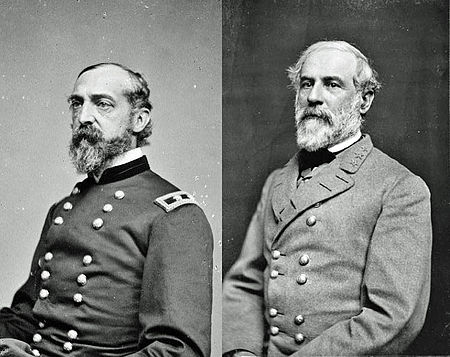
 Left: Union General U. S. Grant; Right, Confederate General John C. Pemberton.
Left: Union General U. S. Grant; Right, Confederate General John C. Pemberton.
On this day, 4 July, in 1863, some 150 years ago, the Confederate garrison of General John C. Pemberton surrendered to Union General U.S. Grant, at Vicksburg, Mississippi, in a siege that had begun in May, 1863. This capitulation, just a day after the defeat of Robert E. Lee at Gettysburg, saw about 29,500 Confederates surrender, and a key stronghold on the Mississippi River fall to Union hands.
 Grant's Operations against Vicksburg, leading up to, and including the Siege. Attribution: Map by Hal Jespersen, www.posix.com/CW
Grant's Operations against Vicksburg, leading up to, and including the Siege. Attribution: Map by Hal Jespersen, www.posix.com/CW
This was a siege that began on 18 May 1863, after Grant and his Union Army of the Tennessee landed in Mississippi, defeated a couple of forces, and maneuvered in position to besiege the city.
Union General Ulysses S. Grant and his Union Army had attempted a number of skemes to strike at the Confederate stronghold on the Mississippi, Vicksburg, during the winter of 1862-1863, but all had failed. At the end of April 1863, his troops landed on the East, or Mississippi, side of the river, to begin the campaign that would, in the end, secure the city. At
Port Gibson on 1 May (
http://www.cr.nps.gov/hps/abpp/battles/ms006.htm), Grant was able to push past local Confederate forces. Likewise, on 12 May 1863, at the
Battle of Raymond (http://www.cr.nps.gov/hps/abpp/battles/ms007.htm), US Grant's Army defeated a Confederate force, allowing him to move on
Jackson, Mississippi, by 14 May 1863, and forcing the evacuating of the Confederate relief army under Joseph E. Johnston (
http://www.cr.nps.gov/hps/abpp/battles/ms008.htm). These actions not only forced Confederate General John C. Pemberton to withdraw back to Vicksburg, but convinced CS General Joseph Johnston, who was to save the army at Vicksburg, to keep his distance and, in the end, remain irrelevant. Grant moved west, crashing into a Confederate body on 16 May 1863 at
Champion Hill (
http://www.cr.nps.gov/hps/abpp/battles/ms009.htm), and, two days later, commenced the siege of the jewel of the campaign: Vicksburg.
 The Siege of Vicksburg, Mississippi. Attribution: Map by Hal Jespersen, www.posix.com/CW
The Siege of Vicksburg, Mississippi. Attribution: Map by Hal Jespersen, www.posix.com/CW
Finally, after weeks of bitter siege, the rations and supplies of soldier and civilian alike in Vicksburg became intolerable. Pemberton was determined to cut his way out of the city, but his subordinate generals argued against this idea. On 2 July 1863, Confederate General John C. Pemberton met with Union General US Grant to discuss terms. Grant offered only unconditional surrender, as is American custom. Pemberton declined. The next day, more reasonable terms were offered, and on 4 July 1863, the Confederate garrison of Vicksburg, Mississippi, some 29,495 men -- in addition to over 3,000 casualties of battle -- surrendered to the Union army. This was but a day after Pickett's Charge at Gettysburg.
The fall of Vicksburg meant that only Port Hudson, Louisiana, which would fall days later, stood in the way of Union domination of the Mississippi River, and a division of the Confederacy in two. Coupled with the defeat at Gettysburg, the Southern Confederacy was dealt a blow from which it would never recover.
For more, you might note:
National Park Service Description of Vicksburg
This is the website of the battlefield that, above all others, this blogger needs to visit:
Vicksburg National Military Park
A site which includes the official reports is:
http://www.civilwarhome.com/siegeofvicksburg.htm
Live well.


